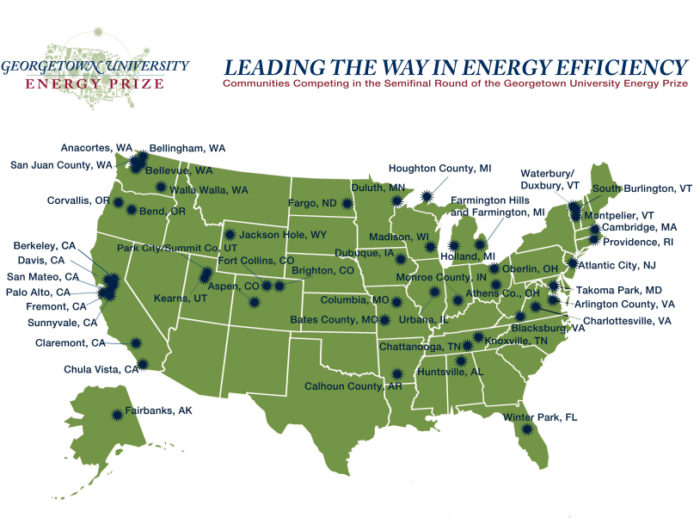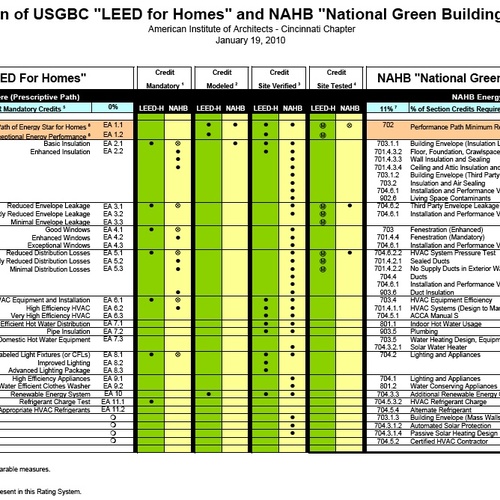
Image Credit: Georgetown University
Fifty small and midsized towns across the country are going head-to-head in a competition with a big payday: $5 million for the town coming up with the best energy-saving strategy.
The 50 communities are semi-finalists for the Georgetown University Energy Prize, first announced in 2014 and now midway through a crucial two-year period in which energy consumption is being watched. The winner will be announced sometime in 2017.
The contest was open to any of the 8,892 communities in the country whose population ranges from 5,000 to 250,000, a pool which prize organizers say includes about 65% of the U.S. population.
In order to get to semi-finalist status, according to rules posted at the Energy Prize site, each community had to develop a long-term efficiency plan. They’re now in the process of showing how effective the plans are in reducing electricity and gas consumption by residential and municipal users (consumption by industrial and commercial users aren’t included, nor are other forms of energy, like gasoline or diesel).
A year from now, judges will begin poring over the results and then select a group of finalists. The winner will be selected from that list on the basis of how much energy the community saved and other factors, including a final report that each town must submit.
Towns and cities still in the running are spread widely across the country. California has the highest number — eight, including Berkeley and Palo Alto — while a number of states have no semifinalists. That list includes New Mexico, Arizona, Montana, Oklahoma, Texas, New York, Idaho, Maine, Pennsylvania, Georgia, and a few others.
No one will be taking any long vacations on the prize money. The winner will have to spend the money on energy-efficiency programs that reward the community as a whole.
Different towns, different approaches
There’s no single path to a $5 million jackpot, as a story recently posted by Minnesota Public Radio goes to show.
The report contrasts two communities: Fargo, North Dakota, a city of about 116,000 (host of this month’s “North of Normal Frostival”), and Duluth, Minnesota, with a population of about 86,000 roughly 250 miles to the east. Both are in one of the coldest regions of the country, with the average number of heating degree days topping 8,500 annually.
In Duluth, specialists like Mike Braun are going house-to-house and fixing seemingly minor problems, such as drafty windows and inefficient lighting, on the theory it will all add up to significant savings.
Braun told Minnesota Public Radio that one day’s worth of air-sealing can cut leakage by as much as 20%. Swapping incandescent light bulbs with LEDs can reduce electricity consumption by two-thirds.
“Little things in aggregate will make a huge difference,” said Bret Pence, director of Community Programs for Ecolibrium3, a nonprofit doing weatherization work in town. “If everyone replaced one incandescent light with an LED light, we would be on our way to winning that competition.”
One challenge is sinking energy prices, which make people think conservation isn’t important. Another is how to improve energy efficiency in the homes of people who don’t have much money to spare. Some poor families that don’t qualify for energy assistance from the state may spend as much as 40% of their income on utilities, Pence said. When it’s tough to put food on the table, replacing incandescent bulbs with LEDs isn’t going to happen.
Ecolibrium3 hopes to work on 50 homes this year.
Energy savings through games
Fargo, the radio report says, is hoping to win with a combination of social engagement and education, plus a game to get people excited about saving energy.
“Behavior, buildings, and policies are the three tracks along which everything is working,” says Malina Srivastava, a North Dakota State University assistant professor of architecture who helped design an online game in which schools and neighborhoods can compete.
Srivastava and other developers created an evil character called Waste-a-Watt, based on drawings by school children. The object at each level of the game, which is to be launched at the end of the month, is to capture Waste-a-Watt and plant a tree.
“We’re asking people to learn, become aware,” Srivastava said. “We’re asking people to act on their own homes to save cost and then we’re asking people to invite their friends and family to join the effort.”
As part of the effort, Srivastava’s students at North Dakota State are to design and build a Passivhaus home on a Habitat for Humanity budget.
Mike Williams, a Fargo city commissioner and energy conservation advocate, said Fargo cut energy use by more than $3 million in the first six months of the competition.
Weekly Newsletter
Get building science and energy efficiency advice, plus special offers, in your inbox.















0 Comments
Log in or create an account to post a comment.
Sign up Log in